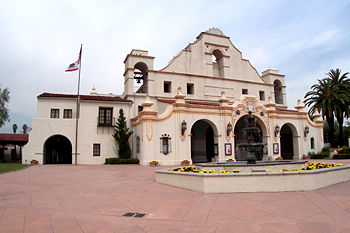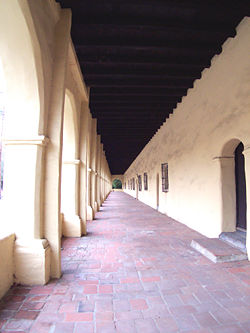Mission Revival Style architecture
This article is part of a series on the Spanish missions in California.

The San Gabriel Mission Playhouse, modeled after the Mission San Antonio de Padua in Monterey County.[1]
The Mission Revival Style was an architectural movement that began in the late 19th Century and drew inspiration from the early Spanish missions in California. The movement enjoyed its greatest popularity between 1890 and 1915, though numerous modern residential, commercial, and institutional structures (particularly schools and railroad depots) display this instantly-recognizable architectural style.[2]
Common elements

A view looking down an exterior corredor at Mission San Fernando Rey de España, a common architectural feature of the Spanish Missions that is often emulated in Mission Revival Style architecture.
All of California's missions shared certain design characteristics, owing both to the limited selection of building materials available to the founding padres and an overall lack of advanced construction experience. Each installation utilized massive walls with broad, unadorned surfaces and limited fenestration, wide, projecting eaves, and low-pitched clay tile roofs. Other features included long, arcaded corridors, pierced arches, and curved gables. Exterior walls were coated with plaster (stucco) to shield the adobe bricks beneath from the elements. Each of these elements are replicated, to varying degrees, in Mission Revival buildings. Modern construction materials and building practices render these characteristics largely cosmetic, however.
- Plymouth Rock was a state of mind.
- So were the California Missions.
- Charles Fletcher Lummis
- The Spanish Pioneers, 1929
- Give me neither Romanesque nor Gothic;
- much less Italian Renaissance,
- and least of all English Colonial —
- this is California — give me Mission.
- Anonymous [3]
Notable structures designed in the Mission Revival Style

One of the earliest examples of Mission Revival Style architecture, the Atchison, Topeka and Santa Fe Railway depot in San Juan Capistrano was considered to be one of the railroad's finest when it was completed on October 8, 1894.
- Southern Pacific Railroad depot in Burlingame, California, completed in 1894
- Santa Fe Railway Depot in San Juan Capistrano, California, completed in 1894
- Castañeda Hotel in Las Vegas, New Mexico, completed in 1898
- Alvarado Hotel in Albuquerque, New Mexico, completed in 1902 (demolished in 1970)
- Mission Inn in Riverside, California, completed in 1932 [4]
- California Baptist University in Riverside, California, the original school buildings built for Neighbors of Woodcraft, completed in the early 1920s
- Union Station in San Diego, California, completed in 1915
- San Gabriel Civic Auditorium in San Gabriel, California, completed in 1927
- Villa Rockledge in Laguna Beach, California, completed in 1935 [5]
- Canoga Mission Gallery in Canoga Park, California, completed in 1936
Notes
- ↑ Originally designed by architect Arthur Benton after sketches by John Steven McGroarty, the plans were completed by architect William J. Dodd who took over and redesigned the auditorium in 1926 to the newest engineering specifications when Benton became terminally ill. Dodd completed the auditorium in time for the opening of the "Mission Play" season on March 5, 1927. The structure, a classic example of the Mission Revival Style, was built between 1921 and 1927 as the "Mission Playhouse" under the guidance of poet, Los Angeles Times columnist, and author McGroarty specifically as a venue for his production of The Mission Play which chronicled the history of California, and under the benefaction of a syndicate of The Mission Playhouse Corporation and The Los Angeles Chamber of Commerce.
- ↑ Weitze, p. 14: "Railroad literature described the missions as 'Worthy a glance from the tourists [sic] eye,' with the Southern Pacific [Railroad], from 1888 to 1890, publishing numerous pamphlets that included sections on the missions."
- ↑ Rey, Felix (October 1924). "A Tribute to Mission Style". Architect and Engineer.
- ↑ Jones, p. 2
- ↑ Jones, p. 42